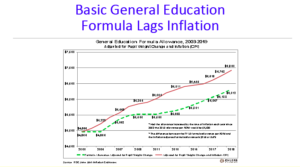Superintendent Dr. Ann-Marie Foucault gave detailed information on the state of the St. Michael-Albertville school district’s $87 million budget Monday evening at the annual Truth in Taxation meeting.
Foucault highlighted the financial challenges facing the district, including inflation and the underfunding of special education.
“Since 2002-2003, the general education formula has not kept pace with inflation, and as you know in your own home, inflation matters to your budget,” Foucault said.
She said funding would need to increase by another $618 per student to cover inflationary cost increases since 2003.

courtesy of STMA school district
When it comes to special education funding, Foucault said that last year they spent $538 on cross subsidies per student. The cross subsidy is the amount the district transferrs from the general fund to cover mandated special education services.
“I want to be clear that we welcome all children into our schools, regardless of whether they have a disability or not,” Foucault said. “But we are mandated by state and federal laws to give them certain services, and it often requires us to take from the general fund. That translates to roughly $3.6 million per year. It’s definitely a challenge for us.”
Levy Increase
The levy increase of 7.33 percent for next year, Foucault said, is dictated by state formulas and tied to student enrollment. The district grew by 143 students over last year, so that leads to funding increases in every category that is calculated based on student enrollment. Also, the state reduced its state aid for debt service, meaning the local levy rate rises. Foucault said this results from a state formula change.
Points of Contention
Board member Hollee Saville was the sole member to vote against certifying the levy. She lobbied for using a portion of the district’s fund balance to cover some costs versus levying the full amount. Meeting attendee Eric Boone also voiced his support for this option. The school district has a healthy fund balance of 2.5 months of expenditures in reserve, which is above Minnesota school district’s state average by about 8 percent and above the district’s policy to keep at least 1.5 months in reserve.
However, the superintendent and other board members pushed back against this idea, saying they keep a healthy reserve because the last economic downturn led to zero percent increases in state funding multiple years in a row, and they want to protect the district in case of future hardships.
“That’s one of the reasons we decided to have a policy for a healthy fund balance,” board member Jeff Lindquist said. “That has been criticized by some; some people think we should spend down that reserve. But I think the consensus of this board is that we keep it higher for contingencies such as this.”
One other reason the board majority resists using the fund balance to reduce the local tax levy is because many funding sources are split between state and local funding. For instance, the building and maintenance fund provides $380 per pupil to replace roofs, repair sidewalks and other maintenance projects. The state pays 2/3 of that total, and local taxpayers provide the other 1/3. If the district chooses not to levy the full amount for any fund that operates in this way, it will reduce not only the local share but also the total it receives from the state.
Open Enrollment
Another speaker, St. Michael resident Layne Roschen, also questioned the board’s policy of supporting open enrollment. He said the school district receives $6,312 from the state per open enrolled student, but the district spends about $9,300 per student. He said that means STMA taxpayers spend about $2 million annually to subsidize non-resident students, not including capital costs if new buildings or additions are needed to house extra students.
Board chair Drew Scherber expressed willingness to look into the open enrollment policy with the new board next year, but he said the current board has maintained their preference for giving area residents a choice to be part of STMA schools.
Foucault said the district cannot close open enrollment, but said they could curtail it. However, she said the district brings in $6 million annually from open enrollees and said the schools can easily absorb open enrolled students. For instance, she said elementary open enrollees equate to approximately 4 students per elementary class.
The school board voted to certify the 2019 levy with a vote of 5-1, with Saville dissenting.